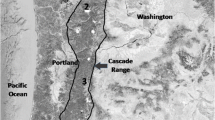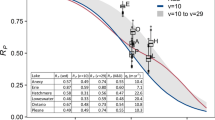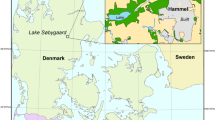Abstract
Transfer functions relating trophic state (Carlson's TSIchlorophyll-a) to present day accumulation rate of (1) nutrients, (2) cations, and (3) organic sediment, are computed using Binford's 210Pb-dilution method. As computed from surficial sediments of 27 lakes, former trophic states are reconstructed for recent (210Pb-dated) sedimentary histories of 14 lakes. Of the three kinds of models potentially available, model (3) (TSI vs. organic accumulation) is the weakest statistically, and may be unduly influenced by exceptional deposition and/or preservation of allochthonous organic matter. At present, however, it is the only model applicable to all 14 of the histories tested. Results are encouraging in that model accurately predicts observed TSI's in several mesotrophic and eutrophic lakes. Clearly significant increases (accelerations) are inferred only for a of the most eutrophic lakes of the set, while the model consistently overpredicts TSI's of the 7 most oligotrophic lakes. As Whitmore's diatom-assemblage index is a better predictor of TSI than is model (3) in the one eutrophic lake in which it has been tested, we expect more persuasive results when models (1) and (2) can be tested within a more complete set of analytical data. We were surprised to find 3 severely disturbed lakes among the 12 that show little or no acceleration in rate of eutrophication in recent decades, but we defer attempts at explanation until former nutrient loading can be tested by model (1).
Similar content being viewed by others
References
Appleby, P. G. & F. Oldfield, 1978. The calculation of lead-210 dates assuming a constant rate of supply of unsupported 210Pb to the sediment. Catena 5: 1–8.
Appleby, P. G. & F. Oldfield, 1983. The assessment of 210Pb data from sites with varying sediment accumulation rates. Hydrobiologia 103: 29–35.
Baker, L. A., P. L. Brezonik & C. R. Kratzer, 1981. Nutrient loading-trophic state relationships in Florida lakes. Publication 56, Water Resources Research Center, Univ. of FL. Gainesville, FL.
Binford, M. W., E. S. Deevey & T. L. Crisman, 1983. Paleolimnology: an historical perspective on lacustrine ecosystems. Ann. Rev. Ecol. Syst. 14: 255–286.
Binford, M. W. & M. Brenner, 1986. Dilution of 210Pb by organic sedimentation in lakes of different trophic states, and application to studies of sediment-water interactions. Limnol. Oceanogr. 31: 584–595.
Brenner, M., 1983. Paleolimnology of the Maya region. Ph.D. thesis, University of Florida, Gainesville, FL. 249 pp.
Brenner, M. & M. W. Binford, This volume. Material transfer from water to sediment in Florida lakes. Hydrobiologia 143: 55–61.
Brenner, M. & M. W. Binford, In prep. Relationships between concentrations of sedimentary variables and trophic state in Florida lakes. Unpublished manuscript.
Brezonik, P. L., W. H. Morgan, E. E. Shannon & A. D. Putman, 1969. Eutrophication factors in north central Florida lakes. Publication No. 5, Water Resources Research Center, Univ. of FL., Gainesville, FL.
Brezonik, P. L. & E. E. Shannon, 1971. Trophic state of lakes in north-central Florida. Publication No. 13, Water Resources Research Center, Univ. of FL., Gainesville, FL.
Canfield, D. E., Jr, 1981. Chemical and trophic state characteristics of Florida lakes in relation to regional geology. Final report to Cooperative Fish and Wildlife Research Unit, Univ. of FL., Gainesville, FL., contract No. 14–16–0009–79–064. 444 pp.
Carlson, R. E., 1977. A trophic state index for lakes. Limnol. Oceanogr. 22: 361–369.
Chapra, S. C. & K. H. Reckhow, 1983. Engineering approaches for lake management. Volume 2: Mechanistic modeling. Butterworth Publishers, Boston, MA. 492 pp.
Deevey, E. S., 1984. Stress, strain, and stability of lacustrine ecosystems. In E. Y. Haworth & J. W. G. Lund (eds.), Lake Sediments and Environmental History. University of Minnesota Press, Minneapolis: 203–229.
Deevey, E. S. & D. S. Rice, 1980. Coluviacion y retencion de nutrientes en el distrito lacustre del Peten, Guatemala. Biotica 5: 129–144.
Deevey, E. S., D. S. Rice, P. M. Rice, H. H. Vaughan, M. Brenner & M. S. Flannery, 1979. Mayan urbanism; impact on a tropical karst environment. Science 206: 298–306.
Dillon, P. J. & F. H. Rigler, 1975. A simple method for predicting the capacity of a lake for development based on lake trophic status. J. Fish. Res. Bd Can. 32: 1519–1531.
Eakins, J. D. & M. T. Morrison, 1978. A new procedure for the determination of lead-210 in lake and marine sediments. Int. J. appl. Radiat. Isot. 29: 531–536.
Frey, D. G., 1955. Langsee: a history of meromixis. Mem. Ist. ital. Idrobiol. Suppl. 8: 141–164.
Goldberg, E. D., 1963. Geochronology with lead-210. In Radioactive Dating, I.A.E.A., Vienna, pp. 121–131.
Huber, W. C., P. L. Brezonik, J. P. Heaney, R. E. Dickinson, S. D. Preston, D. S. Dwornik & M. A. DeMaio, 1982. A classification of Florida lakes. Final report ENV-05-82-1 to the Florida department of Environmental Regulation, Tallahassee, FL.
Rice, D. S., P. M. Rice & E. S. Deevey, 1983. El impacto de los Mayas en el ambiente tropical de la cuenca de los Lagos Yaxha y Sacnab, El Peten, Guatemala. America Indigena 43 No. 2: 261–297.
Shannon, E. E. & P. L. Brezonik, 1972a. Eutrophication analysis: a multivariate approach. Journal of the Sanitary Engineering Division, Proceedings of the American Society of Civil Engineers vol. 98, No. SA 1: 37–57.
Shannon, E. E. & P. L. Brezonik, 1972b. Relationships between lake trophic state and nitrogen and phosphorus loading rates. Envir. Sci. Tech. 6: 719–725.
Thomas, E. A., 1955. Stoffhaushalt und sedimentation im oligotrophen Aegerisee und im eutrophen Pfaffiker und Greifensee. Mem. Ist. ital. Idrobiol. Suppl. 8: 357–465.
Tutin, W., 1955. Preliminary observations on a year's cycle of sedimentation in Windermere, England. Mem. Ist. ital. Idrobiol. Suppl. 8: 467–484.
Vollenweider, R. A., 1968. Recherches sur l'amenagement de l'eau; OECD: (Paris. DAS/CSI/68.27).
Whitmore, T. J., 1985. Diatom transfer functions for assessing the cultural eutrophication of Florida lakes. M.S. thesis, Univ. of Florida, Gainesville, FL. 143 pp.
Zullig, H., 1955. Sedimente als Ausdruck des Zustandes eines Gewassers. Mem. Ist. ital. Idrobiol. Suppl. 8: 485–530.
Author information
Authors and Affiliations
Rights and permissions
About this article
Cite this article
Deevey, E.S., Binford, M.W., Brenner, M. et al. Sedimentary records of accelerated nutrient loading in Florida lakes. Hydrobiologia 143, 49–53 (1986). https://doi.org/10.1007/BF00026644
Accepted:
Issue Date:
DOI: https://doi.org/10.1007/BF00026644




